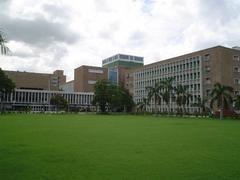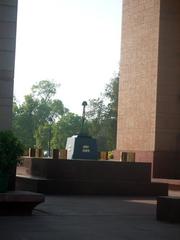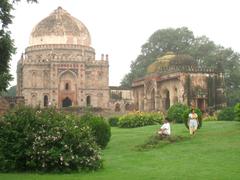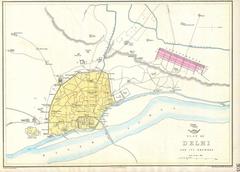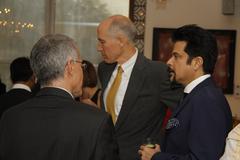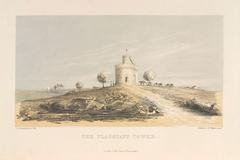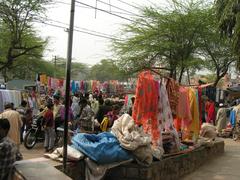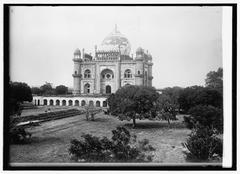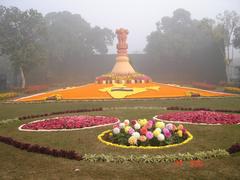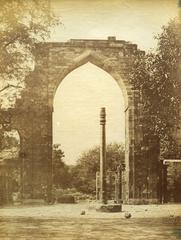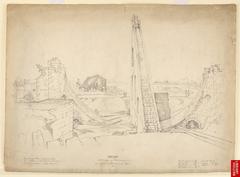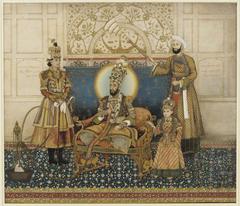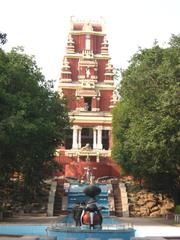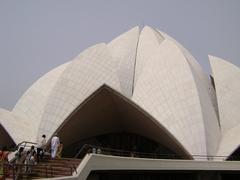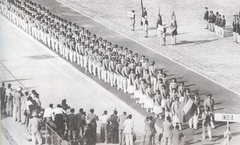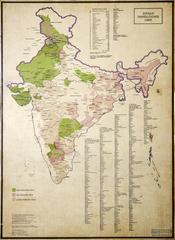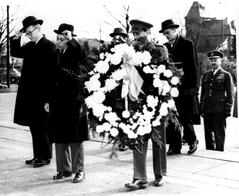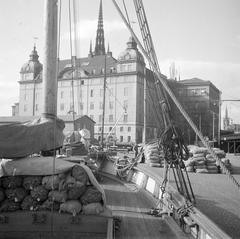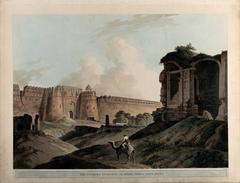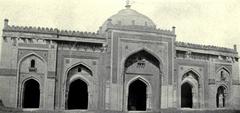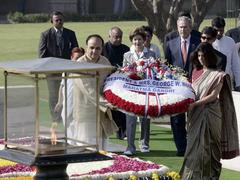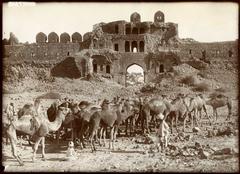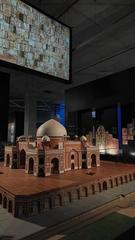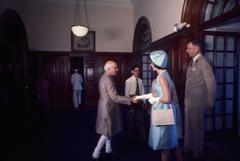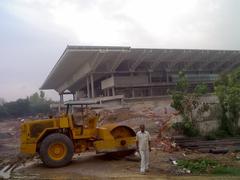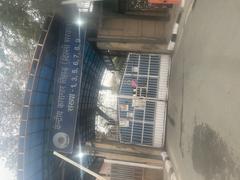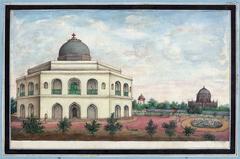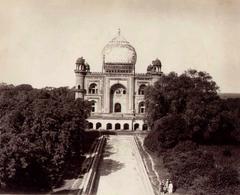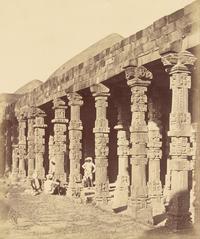Visiting Khirki Masjid: Hours, Tickets, and Historical Significance in New Delhi
Date: 25/07/2024
Introduction
The Khirki Masjid, often referred to as the ‘Mosque of Windows,’ is a fascinating yet lesser-known historical site nestled in the vibrant city of New Delhi, India. Constructed between 1351 and 1354 CE by Khan-i-Jahan Junan Shah, the prime minister of Feroz Shah Tughlaq, this mosque is an architectural marvel that showcases a unique blend of Islamic and indigenous Indian styles. The name ‘Khirki,’ meaning ‘window’ in Urdu, is derived from the mosque’s distinctive feature—its numerous perforated windows that ingeniously provide both ventilation and light. The mosque stands as a testament to the architectural ingenuity of the Tughlaq dynasty, making it a must-visit for history enthusiasts and architecture buffs alike (delhitourism.travel).
Situated in the narrow lanes of Khirki village near Saket in South Delhi, Khirki Masjid is not just a place of worship but also a symbol of the cultural and religious history of medieval Delhi. Its construction during the reign of Feroz Shah Tughlaq, who ruled from 1351 to 1388, was part of a broader initiative to enhance the sultanate’s capital with public buildings, including mosques, colleges, and monasteries. The mosque’s unique architectural elements, such as its covered square plan and quadrangular shape subdivided into two parts, set it apart from other mosques of its time (thewire.in).
In this comprehensive guide, we will delve into the rich history and architectural significance of Khirki Masjid, provide essential visitor information, and offer travel tips to ensure a memorable experience. Whether you are planning a visit or simply wish to learn more about this historical gem, this guide has everything you need to know.
Table of Contents
- Introduction
- Historical Background
- Visitor Information
- Travel Tips
- Nearby Attractions
- Recent Discoveries
- FAQ
- Conclusion
- Call to Action
Historical Background
Origins and Construction
The Khirki Masjid was built by Khan-i-Jahan Junan Shah, the prime minister of Feroz Shah Tughlaq, the third ruler of the Tughlaq dynasty in Delhi. Feroz Shah Tughlaq commissioned the mosque as part of his extensive building projects aimed at enhancing the sultanate’s capital. The mosque’s name, ‘Khirki,’ which means ‘window’ in Urdu, is derived from its unique architectural feature of perforated windows that provide ventilation and light to the structure (delhitourism.travel).
Architectural Significance
The Khirki Masjid stands out for its distinctive architectural style, which is a blend of Islamic and indigenous Indian influences. Unlike typical mosques of the period, which often feature open courtyards, the Khirki Masjid has a covered square plan. This design includes four turrets at the corners and a prominent central dome, making it a unique example of medieval mosque architecture in India (thewire.in).
The mosque is built on an elevated platform, approximately 3 meters high, and covers an area of 87 square meters. The structure is made of rubble masonry and features arched openings, which were innovative for the time. The mosque’s quadrangular shape is subdivided into two parts, each with its own courtyard, further enhancing its architectural uniqueness (tourmyindia.com).
Historical Context
The construction of the Khirki Masjid took place during a period of significant architectural development under the Tughlaq dynasty. Feroz Shah Tughlaq, who ruled from 1351 to 1388, was a prolific builder. In his autobiography, ‘Futuhat-i-Firozshahi,’ he expressed his desire to erect public buildings, including mosques, colleges, and monasteries. The Khirki Masjid was one of seven mosques built by Khan-i-Jahan Junan Shah, showcasing the architectural achievements and the fusion of local elements with Islamic design during this era (thewire.in).
Cultural and Religious Significance
The Khirki Masjid holds a significant place in the cultural and religious history of Delhi. It was built as a symbol of pious contribution towards the sultanate’s capital and served as a place of worship for the local Muslim community. The mosque’s unique design, with its perforated windows and covered courtyards, reflects the innovative architectural practices of the time and the blending of different cultural influences (delhitourism.travel).
Visitor Information
Accessibility and Visiting Hours
Access to the Khirki Masjid can be somewhat challenging due to its location in the narrow lanes of Khirki village near Saket in South Delhi. The mosque is situated close to the Press Enclave Marg and the CityWalk Mall in Saket. The nearest metro station is Malviya Nagar, which is approximately 1.5 kilometers away. Visitors can also reach the mosque by hiring a taxi from the Indira Gandhi International Airport, located about 12.1 kilometers away (yometro.com).
The mosque is open to visitors from 8:00 AM to 7:00 PM, and there is no entry fee. The best time to visit is during the months of July, August, and September, when the weather is relatively pleasant. The mosque attracts a significant number of visitors throughout the year, making it one of the prominent heritage sites in Delhi (yometro.com).
Tickets and Guided Tours
Currently, there are no entry fees or tickets required to visit the Khirki Masjid. However, guided tours are available through various local tour operators. These tours provide valuable insights into the history and architecture of the mosque, enhancing the visitor experience.
Travel Tips
Best Time to Visit
The best time to visit Khirki Masjid is during the cooler months of July to September. The weather is more pleasant, making it easier to explore the site comfortably.
What to Wear
Visitors are advised to wear modest clothing out of respect for the religious significance of the mosque. Comfortable walking shoes are also recommended as the site involves a fair amount of walking.
Local Customs
Be mindful of local customs and traditions. It is advisable to maintain silence and respect the sanctity of the mosque during your visit.
Nearby Attractions
The Khirki Masjid is located in the area of Malviya Nagar, Jahanpanah, which was the fourth city of medieval Delhi. Nearby attractions include the remnants of Jahanpanah, the raised Bijai Mandal Platform, and the Begampur Mosque, which features a variety of domes. Additionally, the Satpula, a bridge structure from the same period, is located close to the mosque. The Satpula, meaning ‘seven bridges,’ is a sluice weir with seven arched main spans and two additional bays at a higher level on the flanks (wikipedia.org).
Recent Discoveries
In recent years, the Archaeological Survey of India (ASI) discovered 254 copper coins from the medieval era at the Khirki Masjid site. This discovery adds to the historical significance of the mosque and provides valuable insights into the economic history of the period (jagranjosh.com).
FAQ
Q: What are the visiting hours for Khirki Masjid?
A: The mosque is open from 8:00 AM to 7:00 PM.
Q: Is there an entry fee for Khirki Masjid?
A: No, there is no entry fee to visit the mosque.
Q: What is the best time to visit Khirki Masjid?
A: The best time to visit is during the months of July, August, and September.
Q: Are there guided tours available?
A: Yes, guided tours are available through local tour operators.
Conclusion
Khirki Masjid is more than just a historical monument; it is a window into the rich cultural and architectural heritage of medieval Delhi. Constructed under the patronage of Feroz Shah Tughlaq, this mosque stands as a testament to the innovative architectural practices of the Tughlaq dynasty. Its unique blend of Islamic and indigenous Indian styles, coupled with its historical and cultural significance, makes it a must-visit for anyone interested in Delhi’s rich past.
Visiting Khirki Masjid offers a unique opportunity to explore a lesser-known yet profoundly significant site. From its distinctive perforated windows to its covered courtyards, the mosque provides a fascinating glimpse into the architectural innovations and cultural dynamics of the 14th century. The lack of an entry fee and the availability of guided tours make it accessible and enriching for all visitors (yometro.com).
In addition to the mosque itself, the surrounding area offers various attractions that complement a visit to Khirki Masjid. The nearby Bijay Mandal, Garden of Five Senses, Kalka Ji Mandir, and Qutub Minar provide additional historical and cultural insights, making South Delhi a rich tapestry of exploration (Trodly).
Preservation efforts by the Archaeological Survey of India (ASI) and local communities ensure that this architectural marvel remains an important heritage site for future generations. Recent discoveries, such as the 254 copper coins from the medieval era, add to its historical significance and provide valuable insights into the period’s economic history (jagranjosh.com).
Whether you are a history enthusiast, an architecture aficionado, or a curious traveler, Khirki Masjid offers a memorable journey through time. By following the travel tips and exploring the nearby attractions, you can make the most of your visit to this remarkable site. For more travel guides and updates, don’t forget to check out our other articles and download the Audiala mobile app.

